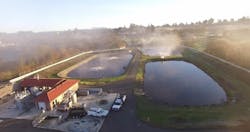Suspended air flotation system
Heron Innovators’ Suspended Air® Flotation (SAF®) system is setting new standards for efficiency and effectiveness in solid/liquid separation. SAF has consistently demonstrated superior performance compared to conventional floatation separation techniques in treating water, wastewater, and landfill leachate.
Suspended Air Flotation enhances separation efficiency, resulting in cleaner effluent and drier skimmed solids. Additionally, SAF significantly reduces operating costs through lower energy consumption, decreased flocculant and coagulant usage, and reduced operator attention and maintenance requirements. Moreover, SAF systems occupy a smaller footprint while increasing hydraulic flow capacity and solids loading capacity.
Heron Innovators has been building and installing Suspended Air Flotation systems across the U.S., Mexico, and Canada for twenty-five years, for a wide range of municipal and industrial water and wastewater treatment applications. These SAF® systems have consistently outperformed traditional flotation methods, including Dissolved Air Flotation (DAF), Cavitation Air Flotation (CAF), Induced Air Flotation (IAF), Induced Gas Flotation (IGF), and traditional microbubble technologies.
SAF achieves this performance by utilizing charged microbubbles, known as aphrons, that do not dissolve. An aphron is a double-walled bubble, 7-25 µm in size, that will not coalesce and has a significantly greater surface area and longer lifespan than traditional DAF bubbles. Aphrons can possess either a cationic or anionic charge. This electrostatic affinity and the resulting surface tension advantage allow aphrons to effectively adhere to, attract, and encapsulate contaminant particles.
SAF systems are available in sizes ranging from 50 gallons per minute (gpm) to greater than 8,000 gpm. Smaller flows can be treated by batch processing. Skid-mounted systems are available with capacities from 50 gpm to 2,800 gpm.
